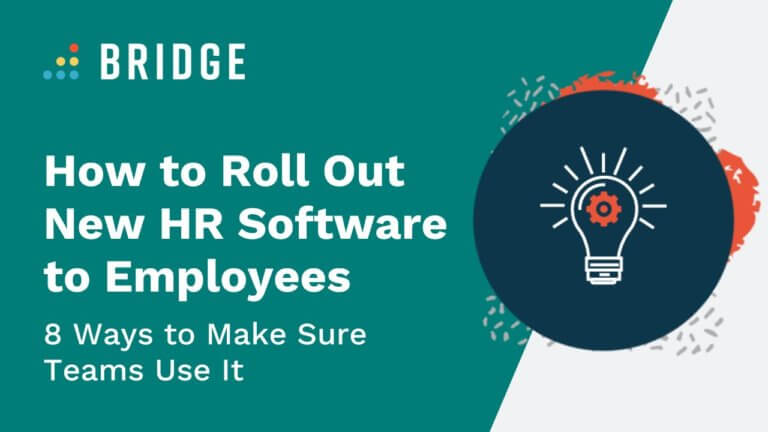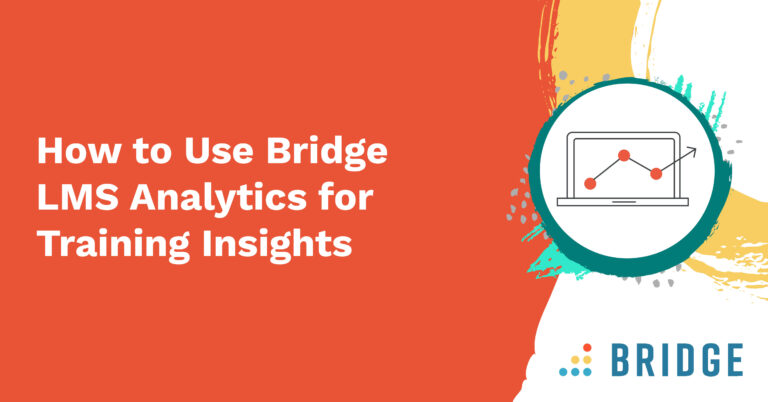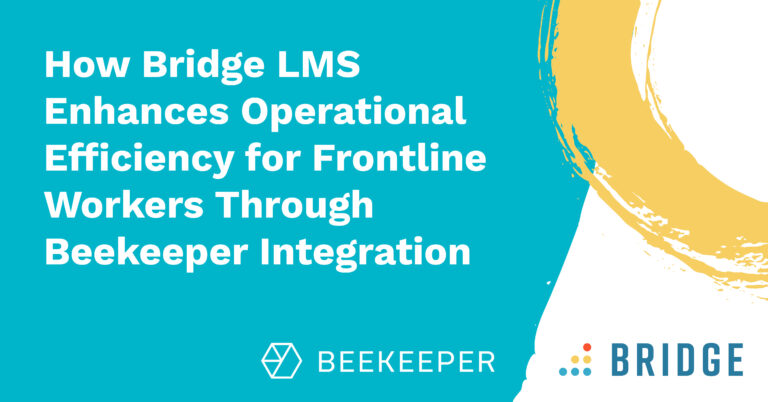Successful organizations constantly evolve by adopting new processes and technologies to meet future needs.
The most valuable tech investment areas for 2023 include skills management, learning management platforms, and internal talent marketplaces, according to research by Gartner. L&D and HR professionals are increasingly looking to these technologies to make better informed decisions and boost value.
However, 57% also believe that employee software adoption is the biggest hurdle to overcome.
Choosing the right HR system is only the beginning. A carefully-planned and executed strategy is needed for employees to see the value in software and unleash its full potential.
Choosing the Right HR Software for Your Organization
Buying HR software can be a big decision. The right technology has the power to integrate with existing systems and data, provide more accurate analytics, and streamline previously admin-heavy processes for more strategic outcomes.
Finding the best solution for your organization and its needs matters. Your will depend on its size, requirements, and future objectives.
Some commonly used types of HR tech can include:
Human Resources Information System (HRIS):
Sometimes used interchangeably with the HRMS and HCM, an HRIS is a centralized database to manage and track employee data.
Learning Management System (LMS):
A learning platform enables admins to design, deliver, and track engaging courses in engaging and dynamic formats.
Performance Management:
HR and L&D professionals, managers, and employees can use this platform to track performance goals and measure development progress.
Employee Engagement:
This can increase employee satisfaction, improve insight into training and data analytics, and highlight trends.
When deployed effectively, the benefits of HR software go beyond just data management and tracking. By bringing together your tools and data and connecting goals, your HR system can create opportunities for growth and development, deliver training that’s tailored to organizational priorities, and communicate your culture.
How to Successfully Roll Out HR Tech to Your Teams
Once your team has found the perfect platform, secured buy-in from stakeholders, and signed the agreement, the implementation strategy starts.
Rolling out a new platform or piece of software takes investment and buy-in from all levels—not just senior stakeholders and leaders. To successfully drive this change and maximize performance, people need to see the value of the tech.
Here are eight rollout and adoption considerations to improve employee engagement and make tech rollout plain sailing:
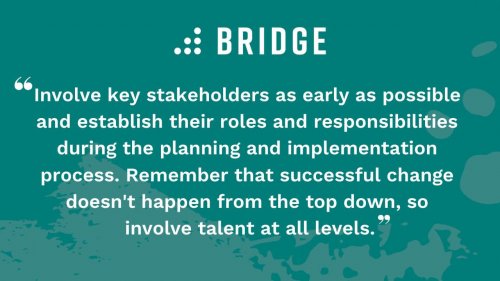
MAKE THE CASE FOR YOUR L&D PROGRAM | ‘Making the Case for Your Learning Platform in a Time of Economic Uncertainty’
1) Create a Software Implementation Timeline
A comprehensive plan makes rolling out new software less of a headache and will help to sustain your initial forward momentum in the long term. During the implementation cycle, the more details your team has fine-tuned, the smoother the setup and configuration process to get everything ready for rollout.
By carefully plotting all actions, requirements, and goals, it’s easier to see the steps to success, quickly respond to any challenges as they arise, and share wins with stakeholders.
Your software vendor will put together a template to guide your team through the process, so use this as a basis and make sure every objective is realistic, achievable, and in line with expectations.
Consider the following when you assign resources, outline messaging, and plot milestones:
- What timeline and milestones is your team working to?
- What support do you require?
- What channels will you use to communicate?
- When will you provide training?
- What resources do you need?
- Over what period will you implement and launch software?
LOOKING FOR AN LMS? | ‘How to Choose an LMS for Your Organization’
2) Define the Goals and Objectives
Preparation is key—define the end goal, the reasons and motivations for your new rollout, and the impact you expect it to have.
It’s helpful to benchmark based on the current state in order to track and report on improvements over time. The more research you can do, the better. Your vendor might be able to offer more insight into industry averages helping you inform expectations and communicate the value to stakeholders, thereby highlighting how the solution will solve current and future challenges.
Always keep the bigger picture in mind when it comes to communicating goals and accomplishments with stakeholders. Although your team will be looking for results like user engagement and satisfaction, be mindful of how this translates to different stakeholders and objectives.
Use the following as a basis to set and track goals:
- What’s the objective of implementing software?
- What are the most critical business needs?
- What metrics will define success, and over what timeframe?
- Does the vendor align with your organization’s culture?
HOW TO SHOW THE VALUE OF YOUR SOLUTION | ‘How to Create an L&D Budget You Can Defend to Your CFO’
3) Identify Your Champions
Involve key stakeholders as early as possible and establish their roles and responsibilities during the planning and implementation process. Your team of experts will communicate regularly to ensure the rollout is going as planned, identify any potential pitfalls, and build the resources to support employees.
Think carefully about each member of the HR software buying team. Here are some of the roles and responsibilities to involve in the process:
Exec sponsor:
Typically someone in the C-suite, this stakeholder is responsible for making decisions and keeping the project aligned with business goals.
Project champion or gatekeeper:
This stakeholder usually conducts research, fields updates, and manages each stage of the development process by reviewing decisions and data.
Subject matter experts:
As the ones with a deep knowledge of organizational processes and industry standards, SMEs can manage and communicate, and train users on aspects of your new HR software.
Influencers:
Influencers are selected to help manage change. They can act as a point of contact for support and advice, fuel enthusiasm and look for opportunities to optimize usage. They should be well-known and respected and share your organization’s purpose and values.
Technical expert:
This may be a member of your IT team who can provide direction on systems and configurations, communicate any additional needs, and oversee the technical aspects like data migration.
Remember that successful change doesn’t happen from the top down, so involve talent at all levels, not just managers and leaders. Gartner’s findings show that when change management strategies apply open-source principles to communicate, share decisions, and bring employees into the process:
- Employee engagement can increase by 38%
- Success rates can increase from 34% to 58%
- Implementation time can decrease by 33%
Though the stakeholders enlisted will vary based on need and requirement, consider the following when you narrow down the process:
- Who will conduct employee training?
- Who is responsible for keeping the project aligned with organizational goals?
- Who can gather, supply, or migrate relevant data?
- Who will handle the configuration and technical requirements?
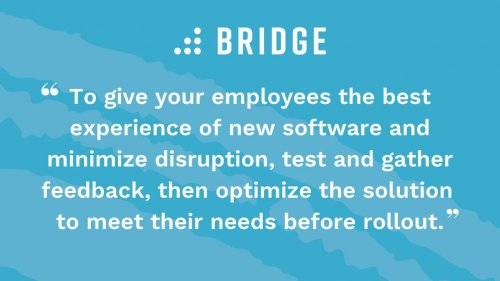
ENGAGE YOUR PEOPLE IN CONVERSATION | ‘Creating a Culture of Conversation’
4) Make Time for Testing Before Rollout
To give your employees the best experience of new software and minimize disruption, test and gather feedback, then optimize the solution to meet their needs before rollout.
Behind the scenes, testing, tracking, and fixing will keep disruption to a minimum. Again, your software provider can share best practices and will be in contact with your IT teams during the launch. They’ll need to check details such as data migration, systems and platform integration, connectivity, and security.
Depending on the size of your organization, consider soft-launching or beta testing to a select number of employees, departments, or locations before widespread adoption. This way, your team can iron out any issues before launch.
Consider these key points and make sure everything’s ready for rollout:
- Does the platform integrate with other systems?
- Did the content, data, or files transfer?
- Is the system secure?
- Is the user interface easy to navigate and understand?
- Does it work across devices?
- Does single sign-on (SSO) work?
- Do all images and videos load?
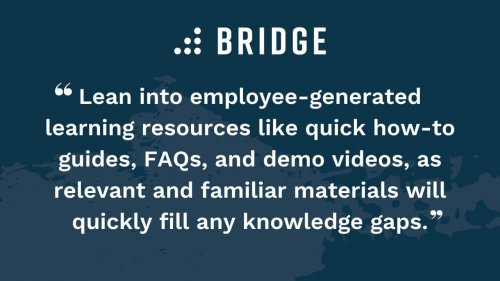
CONTENT CURATION BEST PRACTICES | ‘Build or Buy: 6 Questions to Enhance Your Learning and Development Strategy’
5) Communicate the Value and Purpose of Software
Every interaction is a chance to build trust with people. Ensure that communication is honest, authentic, and clearly shows the value of the software. A shared vision for change goes beyond just telling people how the software will benefit them—they want to know the “why” and the “how” too.
The right message matters, and PwC survey findings show that communication from leaders is one of the most effective and widely used methods for driving HR tech adoption.
Start conversations as early as possible, involving leaders and managers to enforce the message and add the personal touch. While leaders are in the ideal position to share the vision and objective behind the technology, managers can discuss small details with their people. They should share the specifics with their teams and let them know what’s changing, and whether it will affect their processes.
As a guideline, prepare to address the following questions:
- What’s changing?
- Why now?
- What are the benefits?
- What are the goals and objectives?
- What actions do employees need to take?
MORE WAYS TO START MEANINGFUL CONVERSATIONS | ‘4 Ways to Create a Culture of Conversation for Your Organization’
6) Open Channels of Communication With Employees
According to McKinsey, when at least 7% of employees are involved in the transformational process, they’re twice as likely to be successful. This doesn’t mean every employee needs to be involved at each step, but communicating in both directions gives people a voice and a part to play in shaping culture. Not only that, but when it’s time to go live, you already have a way of measuring their satisfaction and preferences.
Initiatives that start conversations should always be welcomed. Whether it’s Q&A sessions, live webinars, or smaller-scale actions like managers filtering information down to their teams, make time to keep people informed and stay open to feedback.
It’s natural for employees to have questions and suggestions, and addressing them early on creates trust and shows that opinions are valued and respected. Leaders and managers should communicate an open-door policy for employees to share their thoughts. However, as not everyone will feel comfortable participating in conversation, anonymous engagement surveys can spark open and honest feedback.
Consider the following questions when approaching feedback:
- How will you gather employee feedback?
- How will employee feedback be addressed?
- How often will employees be asked for input?
- What metrics will you use to measure employee engagement and satisfaction?
CREATE A CONNECTED CULTURE | ‘3 Employee Engagement Ideas for Remote Workers’
7) Prioritize Training and Ongoing Support
A rollout strategy should allow plenty of time to train and guide people. Take advantage of any resources on offer, make training a priority, and tap into the power of your subject matter experts and champions around the business who reinforce messaging.
Your employees need to see value in what they’re learning. Rather than sending a “how-to” guide with little context, break modules down into pathways of content to show them the benefits in a relevant, engaging environment. Include plenty of time for hands-on training and testing, building on small tasks to create familiarity and help people see how they’ll use it in the day-to-day.
Additionally, lean into employee-generated learning resources like quick how-to guides, FAQs, and demo videos, as relevant and familiar materials will quickly fill any knowledge gaps. It’s also helpful to nominate points of contact for employees to turn to with questions on an ongoing basis when the system goes live.
Remember to account for differences in learning and communication styles, and adapt training and delivery methods accordingly. Factor in language differences, different levels of digital fluency, and adapt information for learners outside your organization. Some groups naturally need more in-depth details, so keep communication personal and avoid “send-to-all” style training.
Think about the following questions:
- What training does your provider offer?
- How much support do employees need?
- What formats will you use to deliver training?
- What SMEs and content champions will provide training resources?
HOW TO MAKE TRAINING A PRIORITY | ‘Beating Burnout: Why Microlearning Is a Must for Time-Poor Teams’
8) Refine Strategy to Sustain Value in the Long Term
Once the rollout is complete, there’s still work to do as success comes from employees using and maintaining tech to improve outcomes. Keep a close eye on the initial goals alongside results like user numbers and requests for help to show what’s working well and whether the implementation had the desired result.
While more than half of transformations lose value during or after implementation, the most successful organizations create and sustain value by embedding transformation processes into ‘business-as-usual’ workflows, according to McKinsey.
Your vendor should continue to offer ongoing support and education. Beyond this, you’ll also need to refresh and refine materials to onboard new users and admins. Plan for scaling and look for ways to enhance value, as a valuable investment should meet needs both today and be adaptable as your business changes and grows.
Before software rollout, consider the following questions:
- How will your team encourage ongoing adoption?
- Who are your system administrators?
- How will you train new and existing employees?
- Who’s responsible for providing employee support?
- Is there scope to streamline or integrate additional processes in the future?
- How will you evaluate ongoing success?
MEASURE EMPLOYEE OUTCOMES WITH THE RIGHT METRICS | ‘What Are SMARTER Goals and How Do They Help Measure Employee Productivity?’
Start the Journey to Greater Organizational Success With Bridge
Improve performance outcomes and transform your culture with Bridge. With our all-in-one learning platform, everything your organization needs to align goals, build skills through personalized training, and engage your people is in a single intuitive dashboard.
Bring your tools and data together to assess the real-time impact of skills building, assess satisfaction, and measure the value of your investment by aligning outcomes to business goals.
